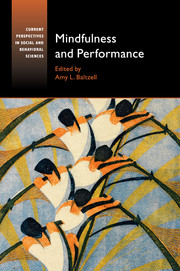Book contents
- Frontmatter
- Dedication
- Epigraph
- Contents
- List of figures
- List of tables
- List of contributors
- Preface
- Acknowledgments
- I INTRODUCTION TO MINDFULNESS: HISTORY AND THEORETICAL UNDERSTANDING
- II FORMAL MINDFULNESS INTERVENTIONS IN SPORT
- III MINDFULNESS: THEORY TO PRACTICE IN SPORT AND EXERCISE
- IV MINDFULNESS AND THE PERFORMING ARTS
- 15 Langerian Mindfulness and Optimal Performance
- 16 Mindfulness and Dancers
- 17 Attention, Centering, and Being Mindful: Medical Specialties to the Performing Arts
- 18 Mindfulness in Music
- V MINDFULNESS FOR COACHES, PRACTITIONERS, AND MENTORS
- VI FUTURE DIRECTIONS
- Index
- References
18 - Mindfulness in Music
from IV - MINDFULNESS AND THE PERFORMING ARTS
Published online by Cambridge University Press: 05 January 2016
- Frontmatter
- Dedication
- Epigraph
- Contents
- List of figures
- List of tables
- List of contributors
- Preface
- Acknowledgments
- I INTRODUCTION TO MINDFULNESS: HISTORY AND THEORETICAL UNDERSTANDING
- II FORMAL MINDFULNESS INTERVENTIONS IN SPORT
- III MINDFULNESS: THEORY TO PRACTICE IN SPORT AND EXERCISE
- IV MINDFULNESS AND THE PERFORMING ARTS
- 15 Langerian Mindfulness and Optimal Performance
- 16 Mindfulness and Dancers
- 17 Attention, Centering, and Being Mindful: Medical Specialties to the Performing Arts
- 18 Mindfulness in Music
- V MINDFULNESS FOR COACHES, PRACTITIONERS, AND MENTORS
- VI FUTURE DIRECTIONS
- Index
- References
Summary
Research about the integration of mindfulness into music teaching and learning is still in its infancy. Much of the writing on music and mindfulness relates to the use of music listening as an external entry point to support focus and facilitate mindfulness (Csikszentmihalyi, 1996; Diaz and Silveira, 2013). People listen to music, in part, to help them to enter a mindfulness state, with mindfulness defined as “paying attention in a particular way: on purpose, in the present moment, and nonjudgementally” (Kabat-Zinn, 1994, p. 4). It is somewhat ironic, however, that an art form that can lead to mindfulness and aid flow of listeners, in those who receive the music, is often a source of great stress and anxiety for those who create the music (Patston, 2014).
This chapter will consider the role of mindfulness in the act of music making itself, from both the perspective of the music teacher and music student. Studio music teachers (instrument and vocal) are not part of traditional, formal student education, with little specific education for studio music teachers within higher education. Music Instruction Non-Deficit (MIND), a new model of musical pedagogy designed for studio teachers, will be presented. My thirty years of professional experience working as a researcher, performer, and educator with studio teachers in a range of fields, from pop to music theater, jazz, and classical, across a broad range of instruments, from schools to universities and professional private studios, has led to the conceptualization of this model. In this chapter, I will present the conceptual support for the model and an overview of the MIND model for studio music teachers. The MIND model is designed to extend the joy of music for both the music studio teacher and music studio students. Mindfulness of what is good and right throughout the teaching and practice of studio music is core to the MIND model.
Music is important to the human experience. There is no human culture on the planet without music, and there is evidence of musical instruments existing for over thirty-five thousand years (Conard, Malina, & Munzel, 2009). The role of music in ritual and storytelling is embedded in our collective consciousness. Recent advances in neuroscience reveal that language and music evolved simultaneously in the human brain (Harvey, 2012) and that music involves virtually all of the cognitive processes (Levitin, 2009).
- Type
- Chapter
- Information
- Mindfulness and Performance , pp. 412 - 436Publisher: Cambridge University PressPrint publication year: 2016
References
- 3
- Cited by



